
Primordial sea was technically the most challenging quilt I have ever made. I arranged all the elements of my design in Photoshop and printed it out to size on close to 100- 8 1/2"x 11" sheets of paper. I arrange the pages on the floor and tape them together with clear packing tape. It makes a large strong cartoon (artist preliminary sketch) with all the tape reinforcement. I start all my large quilts this way.
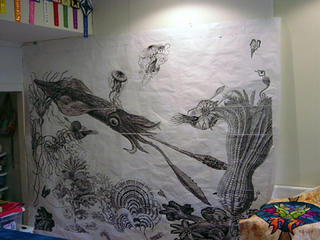
I wanted to use silk for this quilt, the luminous way light reflects from it would be ideal for water. I ordered the widest silk charmuese I could get from
Dharma Trading and sewed two pieces together to make a 6 foot by 8 foot wide panel of silk. Then I hand dyed it twice in shades of turquoise, cerulean and navy.
I tried tracing my design on to the silk using a light box but found the blue to dark to see through. So I re-taped my fabric under my design and used white Saral transfer paper to transfer the image.
I began to paint and found out two things. One- silk stretches and two- translucent textile paint turns black when you paint on blue silk. To solve the first problem freezer paper became my best friend. Each time I painted an area I ironed a strip of freezer paper to the back of my fabric. Then I carefully painted up close to the edge of the paper, then repositioned the freezer paper adjacent and just underneath the area I was painting so I would not get a line from the paper showing up in the paint. Any little bump or grain of sand under the fabric will show up in the painting.
To solve the next problem I painted each object in shades of white to create a base for the paint colors, allowing the blue fabric to show through in the areas I wanted the darkest shades.

The next problem I ran into, was the chalk lines from the Saral paper started to rub off and disappear as I worked. I found myself having to rely on looking up at the original cartoon on the wall and re drawing things by hand because there would be no way to realign the drawing and quilt again and re transfer the images. So things changed shape sometimes and had different kinds of details. This is also when I started to add things that were not in the original cartoon, like several more types of seaweed, a sponge, a large pink anemone, a trilobite, a clam and a snail.

You can see the lines for the giant sea lilly have all but disappeared.
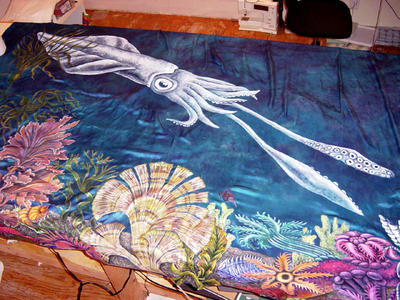
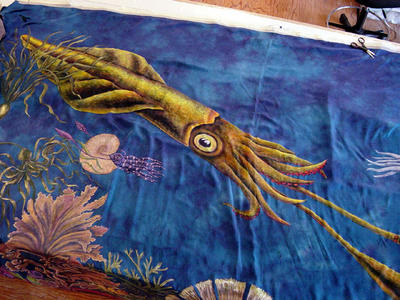
Finished Painting.
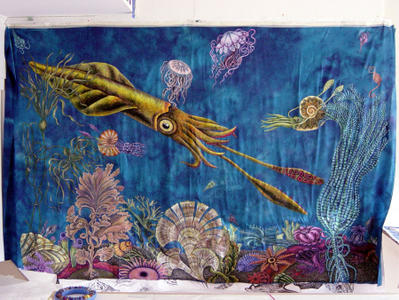
I was terrified to quilt this quilt. One; it was big, two; I was using slippery silk and slippery wool batting, and three; any mistakes in the quilting (puckers in the fabric, stitches that need to be removed) were really going to show. I thought of spray baste, but was afraid of its chemical effect on the silk and what if it stained it with splatters? Also where would I be able to lay a piece of silk this big outside safely to spray, and after vigorous manipulation while machine quilting, would it loose its adhesion? Hand basting seemed too daunting on this one. Then I thought of fusible web. Something I am ambivalent to use because I do not like the stiff flat quality. Wool batting has a lot of loft and you would lose all that texture by using something like wonder under. I remember
Esterita Austin saying that she had a new fusible web product that was very light. So when she came to teach at our Glendale, CA Quilt show I bought a package of
Misty Fuse.
I made a sample using the fusible web, sandwiched between a piece of silk and wool batting. I loved the results. The fusible is like a spider web it is so light. I fused the whole hand dyed and painted sheet of silk to the wool batting, very carefully in two steps.
First I fused the web to the silk in rows, using parchment paper as a backing sheet. The slight overlaps were invisible after fusing. Then on the backing fabric, I fused a one-inch square of web every 6 inches and fused it to one side of the batting. Next I spread the fused backing and batting on the largest carpeted floor in the house and carefully fused my silk top to the wool batting starting in the center and working outwards. This took hours, but it was well worth it. The
Mistyfuse held up like a dream under heavy machine quilting, it never lost its adhesion.
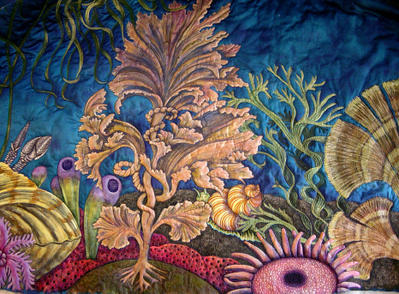
When I start my quilting, I always try to think about how my stitching lines could enhance the image that I am quilting. What kind of detail can I add? How can the quilting make the object appear more dimensional or textured?

You would not think thread would make such a big difference to the work when you are doing the quilting. But look at the difference in the quilted fin of the squid and the unquilted one. The quilted side is so much richer.

While discussing the quilting of the water online with my art quilt group,
Vickie Hallmark mentioned putting plankton into the quilting. What a great idea! There are lots of little plankton hidden in the quilting of the water all over the quilt.
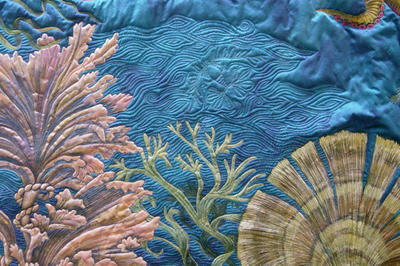
Quilters always like to look at backs of quilts. For a long time I thought that was kind of strange. But I kind of get it now. It is fun to see the picture with out all the color, and see all that crazy quilting.

I hate doing labels, so I thought I would try and have more fun with this one. It is painted and quilted.


 These dye recipes are all mixed with one cup of water
These dye recipes are all mixed with one cup of water Orange Ochre
Orange Ochre










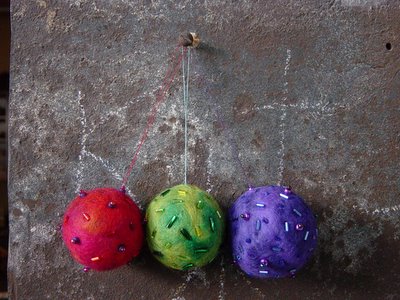















































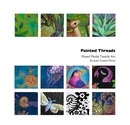
























Once again I was curious what paints you use, so went clicking on your side bar...ta da...the info I was curious about....now a question...What paint brushes do you use? And do you use other things, like pencil erasers, for dots and other details?
Vicky,
I only use brushes when I paint, I find that I do not have enough control when using other things. I don't use top of the line or bottom of the line brushes, but I always buy them from an art supply. Cheap brushes loose hair, and there is nothing worse than picking hairs out of wet paint. They also can loose their points and shape pretty fast, so you loose the ability to make smooth lines. Generally I look for brushes suitable for acrylics, watercolor brushes are too soft. Oil brushes tend to be stiffer, sometimes that is a good thing but in general it is not what I am looking for. I have a lot of brushes, some I have had for 20 plus years.
The shapes and sizes I tend to use most are a flat size 3 and 2, a round size 1, and for details a 00000 and this other one says 10/0. I use those last ones for details like outlining eyes and drawing hairs on the animals in Arbol de Vida, you can see that specifically on the picture of the boar.
I have been a lurker and a fan for a long time now! Your art is amazing! You are so talented! I have a questions, when you quilt, do you use a regular sewing machine or a longarm?
I use a regular sewing machine. I have two older models; a Bernina 1630 that I have been using 13 years and an older Pfaff creative 1475 that I bought used some years ago. Each one has features that I like.
I came across this quilt while looking through a flickr group. I am a painter who recently took up quilting (we're talking RECENTLY- in the middle of my first quilt). I am so fascinated by this process and would love to know where you get your paints. THANKS!
Hi Katie,
I buy most of my paints from Dick Blick. The majority of my textile paints are from Jacquard but I also have Setacolors and some Stewart Gil paints as well. To get certain colors I have mixed the different brands together with no problems. You can sometimes find textile paints at big craft stores too.
Amazing--thanks for sharing your techniques. To get the black background, do you paint it in or work on black fabric?
Thanks, the black is painted. It would be hard to get the bright colors for the animals if it was painted on black fabric.
Brilliant work, Judy! I just had the pleasure of seeing some of your other work at the Denver Quilt festival this weekend. Thanks for sharing your process! Your work is truly inspiring.
When you paint on silk, what type of silk do you use (and where do you purchase it)?
Also, I sometimes find it difficult to quilt through fabric after it's painted. Do you have any tips around technique, needle size, and thread?
Thanks kath,
I bought 19mm silk charmuese from Dharma trading for Primordial Sea. If you ever decide to paint on silk with textile paints make sure you go to my post on the making of Primordial Sea to see some of the technical issues i dealt with to save yourself some possible frustration.
I have never had a problem sewing painted fabric. Are you using textile paints? having sharp new needles in your machine may help. I know some sewing machines can be temperamental though.
Usually I quilt with Organ brand titanium needles. Titanium stays cooler and is easier to use with specialty threads, but I like them because they do not snap off like other sewing needles if you hit the throat plate. They just bend up in a hook shape. I think they may stay sharp longer too.
The thread I use most often is Superior Rainbows. I love the colors and sheen, similar to rayon but stronger since it is polyester. I like Madeira polyneons too.